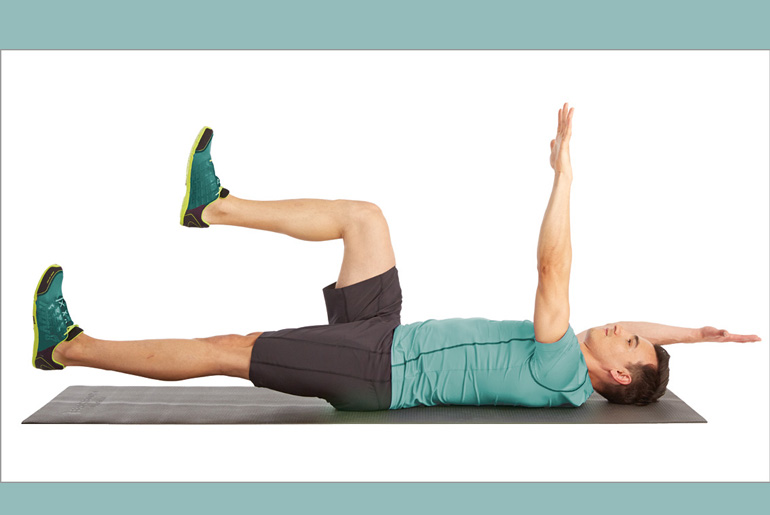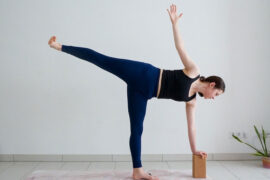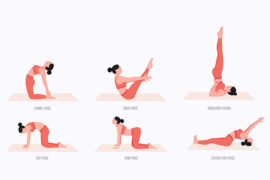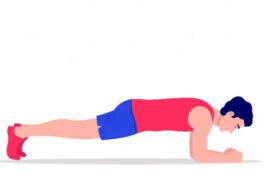The dead bug exercise emerges as a crucial addition to traditional core workouts like crunches and planks, offering an effective means to strengthen the core muscles, including the abdomen, lower back, and pelvic region. Recognized for its ability to enhance core stability and overall strength, the dead bug exercise is beginner-friendly, making it accessible for individuals not accustomed to regular gym sessions. Performing this exercise involves lying on your back and alternately extending opposite arms and legs, engaging the core throughout the controlled movements. The dead bug exercise stands out as a versatile option for those seeking to tone their bodies and improve core strength, regardless of their fitness background.
Dead bug exercise:
The dead bug exercise is a highly effective core-strengthening exercise that targets the hip flexors, lower back, and abdominal muscles. This exercise is renowned for its ability to improve coordination, stability, and overall core strength, as explained by bodybuilder and fitness trainer Chitharesh Natesan. The name “dead bug” originates from the distinctive posture of the exercise, resembling a dead bug lying on its back, with arms and legs extended upward. This exercise involves controlled movements of alternating arm and leg extensions while maintaining core engagement, making it a popular choice for individuals looking to enhance their core fitness and stability.
How to do the dead bug exercise?
To correctly execute the dead bug exercise, begin by lying on your back with arms extended toward the ceiling and knees bent at a 90-degree angle, ensuring your lower back is pressed into the mat to engage the core. Slowly lower one arm and the opposite leg towards the floor without touching it, then return to the starting position. Alternate sides in a controlled manner, coordinating your breathing. It is crucial to avoid common mistakes such as arching the lower back and excessive craning of the neck, as these errors may result in pain and discomfort. Maintaining proper form is essential for maximizing the benefits of the dead bug exercise, which focuses on strengthening the core muscles, improving balance, and enhancing overall stability. Start with a manageable number of repetitions, emphasizing controlled movements to gradually progress in strength and coordination.
How dead bug exercise help strengthen the core?
The dead bug exercise is a core-strengthening workout that demands active engagement of the abdominal muscles to maintain balance while moving the arms and legs. By requiring the core muscles to stabilize the spine and pelvis throughout the controlled movements, this exercise effectively targets the rectus abdominis, transverse abdominis, and oblique muscles. The dynamic and alternating nature of the dead bug exercise not only improves power in the core but also enhances overall balance and coordination. A fast-paced workout further challenges the core muscles, testing their ability to cooperate and providing a comprehensive approach to core strength. This exercise proves beneficial for building both power and endurance in the core, contributing to improved stability and reducing the risk of related injuries.
Benefits of dead bug exercise:
The Dead Bug exercise offers a range of benefits, primarily focused on strengthening the core muscles. Here are some key advantages:
1. Core Strengthening:
- Engages multiple muscles in the core, including the rectus abdominis, transverse abdominis, and obliques.
2. Postural Improvement:
- Strengthens the muscles that support the spine, contributing to better posture.
3. Spinal Stability:
- Promotes stability in the spine by working on the muscles that surround and support it.
4. Hip Flexor Strength and Flexibility:
- Improves strength and flexibility in the hip flexors, which play a crucial role in various movements.
5. Deep Core Activation:
- Targets deep core muscles, including the transverse abdominis, aiding in overall core activation.
6. Reduced Risk of Lower Back Pain:
- Strengthens the muscles in the lower back and abdomen, reducing the risk of lower back pain.
7. Improved Coordination:
- Requires coordination between the upper and lower body, enhancing overall body awareness.
8. Versatility in Use:
- Can be incorporated into various fitness routines, including strength training and Pilates.
9. Physical Therapy and Rehabilitation:
- Widely used in physical therapy and rehabilitation programs to improve core stability and function.
10. Accessible for Various Fitness Levels:
- Can be modified for different fitness levels, making it suitable for beginners to advanced practitioners.
11. Enhanced Functional Movement:
- Strengthens muscles that contribute to everyday movements, improving overall functional fitness.
12. Prevention of Muscular Imbalances:
- Helps prevent muscular imbalances by targeting both the anterior and posterior chain.
13. Mind-Body Connection:
- Promotes a connection between the mind and body, requiring focus and concentration during execution.
14. Dynamic Core Activation:
- Involves dynamic movements, providing a more comprehensive approach to core activation compared to static exercises.
Incorporating the Dead Bug exercise into a well-rounded fitness routine can contribute to overall core strength, stability, and flexibility. As with any exercise, it’s essential to perform it with proper form and technique to maximize its benefits and reduce the risk of injury. If you have any pre-existing health conditions or concerns, it’s advisable to consult with a fitness professional or healthcare provider before starting a new exercise program.
Tips for beginners:
Certainly, the Dead Bug exercise is beginner-friendly, and it’s essential for beginners to focus on proper form and gradually increase intensity. Here are some tips specifically tailored for beginners:
1. Start with a Small Range of Motion:
- Begin with a small range of motion to maintain control and avoid straining your lower back.
- As you become more comfortable with the movement, you can gradually increase the range.
2. Focus on Proper Form and Technique:
- Emphasize proper form over speed. Slow and controlled movements are more effective for engaging the core muscles.
- Ensure that your lower back remains pressed against the mat throughout the exercise.
3. Engage Your Core Muscles:
- Actively engage your core muscles throughout the entire exercise.
- Focus on drawing your navel toward your spine to maximize the benefits for your abdominal muscles.
4. Listen to Your Body:
- If you experience any discomfort, especially in the lower back, reduce the range of motion.
- Pay attention to your body’s signals and adjust the exercise accordingly.
5. Consult with a Fitness Professional:
- If you have any concerns or specific conditions, consider consulting with a fitness professional or healthcare provider.
- They can provide personalized guidance and modifications based on your individual needs.
6. Gradual Progression:
- Start with a moderate number of repetitions, such as 8 to 10 on each side.
- Progressively increase the number of repetitions as you gain comfort and strength.
- Gradual progression helps prevent overexertion and allows your body to adapt.
7. Combine with Breathing:
- Coordinate your breath with the movements. Inhale as you lower your arm and leg, and exhale as you return to the starting position.
- Proper breathing enhances the effectiveness of the exercise and promotes relaxation.
8. Quality Over Quantity:
- Focus on the quality of each repetition rather than the quantity.
- Ensure precise movements and a strong mind-body connection for optimal results.
9. Use Supportive Equipment:
- If needed, use a yoga or exercise mat to provide comfort and support for your back during the exercise.
Remember that everyone progresses at their own pace, and it’s okay to modify the exercise to suit your current fitness level. Consistency and proper form are key to reaping the benefits of the Dead Bug exercise safely and effectively. If you’re unsure about your form or have any concerns, seeking guidance from a fitness professional is a good idea.
Variations of the dead bug exercise:
Absolutely! The Dead Bug exercise is versatile, and variations can add new challenges to target different muscle groups. Here are a few variations of the Dead Bug exercise:
1. Weighted Dead Bug:
- Hold a light dumbbell or medicine ball in your hands while performing the exercise.
- This adds resistance, increasing the challenge to your core muscles.
2. Extended Limb Dead Bug:
- Instead of keeping your knees bent at a 90-degree angle, fully extend your legs.
- Lower one arm and the opposite leg toward the ground and return to the starting position.
- This variation increases the lever length, intensifying the workout for your core.
3. Bent-Knee Dead Bug with Stability Ball:
- Place a stability ball between your knees while performing the exercise.
- Squeeze the ball with your knees, adding an extra element of stability and engaging inner thigh muscles.
4. Diagonal Dead Bug:
- Extend one leg straight while lowering the opposite arm diagonally toward the floor.
- Return to the starting position and repeat on the other side.
- This variation challenges the obliques and adds rotational movement.
5. Reverse Dead Bug:
- Lie on your stomach and extend your arms overhead.
- Lift one arm and the opposite leg off the ground simultaneously.
- Return to the starting position and repeat on the other side.
- Targets the lower back and posterior chain.
6. Dead Bug with Rotation:
- Add a rotational movement by twisting your torso as you lower one arm and the opposite leg.
- Return to the starting position and repeat on the other side.
- Engages the obliques and improves torso mobility.
7. Seated Dead Bug:
- Sit on the floor with your knees bent and feet flat.
- Lift your feet off the ground, balancing on your sit bones, and extend your arms and legs.
- Move your arms and legs in a controlled manner for a seated variation.
8. Cross-Body Dead Bug:
- Instead of straight down, lower one arm across your body while extending the opposite leg.
- Return to the starting position and repeat on the other side.
- Emphasizes diagonal movement and targets the obliques.
These variations add diversity to your core workout, targeting different muscle fibers and enhancing overall stability. Incorporate these variations based on your fitness level and goals. As with any exercise, maintain proper form and start with a variation that suits your current abilities, gradually progressing as you become more comfortable.
Disclaimer:
The information contained in this article is for educational and informational purposes only and is not intended as a health advice. We would ask you to consult a qualified professional or medical expert to gain additional knowledge before you choose to consume any product or perform any exercise.








